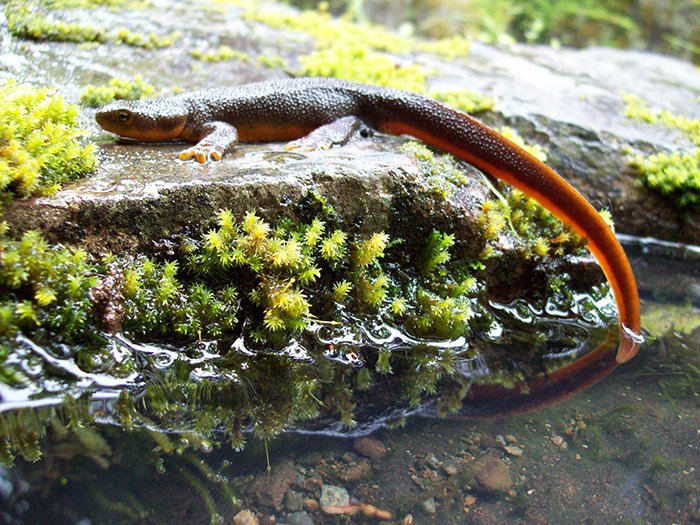Newts in the Rough
DSHil, CC BY-SA 4.0, via Wikimedia Commons
Taricha
by Inspector Barry Mins on February 21, 2023Hey kids, welcome back to our series on the mysteries of created kinds. Last time, we met a stunning group of birds. This week we’re moving from the jungles of the Amazon to the west coast of North America, looking for a colorful kind of newt.

The newts of this kind are colorful, with a bright red underside and a darker upper body. The bright red color serves as a warning: these newts are toxic. The poison can kill mammals and birds easily, while snakes tend to be a little more resistant but still often die from eating the newt. The exact amount of poison varies between species and even within populations of the same species. When bothered by predators (or curious humans), the newts will secrete up to 90% more toxin from their skin. When females lay eggs, they pass their own toxicity on to the eggs, meaning that the eggs themselves are also poisonous.
The diet of these newts is effectively any small invertebrate it can catch. Because like most newts, it needs to be near water, many of its prey are also water dependent in some way, like snails or mosquito larva. Occasionally, some species will snack on fish eggs as well as invertebrates.
Breeding occurs in the water, and females lay eggs in the water, often among the leaves of water plants or mosses. The young hatch and go into a tadpole stage in which they have to live in water. When metamorphosis into the adult stage occurs, the newt will leave the water and start to forage on land. The adult newts have a remarkable ability to find their way home, even over miles of rough terrain.
Has anyone figured it out yet? This week’s kind is the Taricha—the rough-skinned newt kind. Stay tuned for next week when we start looking for a family of American rodents.

Orange Collared Manakin
Jsayre64, CC BY-SA 3.0, via Wikimedia Commons
Try out this fun crossword!
Clue
Your clue for the week is:
These rodents may look cuddly, but you really don’t want to hug one.
Ask a Question
Have you ever had a question about created kinds but didn’t know who to ask? Have you ever wanted to learn more about your favorite kind? Well, now you can! You can ask me, Inspector Barry Mins, a question! Have your parents help you fill out this form, and you might get your question answered in my column! If you have any questions about created kinds, feel free to send them my way!
Footnotes
- Edmund D. Brodie, Jr., “Investigations on the Skin Toxin of the Adult Rough-Skinned Newt, Taricha granulosa,” Copeia 1968, no. 2 (1968): 307–313.
- C. T. Hanifin, M. Yotsu-Yamashita, T. Yasumoto, E. D. Brodie III, and E. D. Brodie, Jr., “Toxicity of Dangerous Prey: Variation of Tetrodotoxin Levels Within and Among Populations of the Newt Taricha granulosa,” Journal of Chemical Ecology 25, no. 9 (1999): 2161–2175.
- B. L. Cardall, E. D. Brodie Jr., E. D. Brodie III, and C. T. Hanifin, “Secretion and regeneration of tetrodotoxin in the rough-skin newt (Taricha granulosa),” Toxicon 44, no. 8 (2004): 933–938.
- C. T. Hanifin, E. D. Brodie III, and E. D. Brodie, Jr., “Tetrodotoxin Levels in Eggs of the Rough-Skin Newt, Taricha granulosa, Are Correlated with Female Toxicity,” Journal of Chemical Ecology 29, no. 8 (2003): 1729–1739.
- V. Twitty, D. Grant, and O. Anderson, “Long distance homing in the newt Taricha rivularis,” Proceedings of the National Academy of Sciences 51, no. 1 (1964): 51–58.
- © 2024 Answers in Genesis
- Privacy Policy
- Contact
- About
